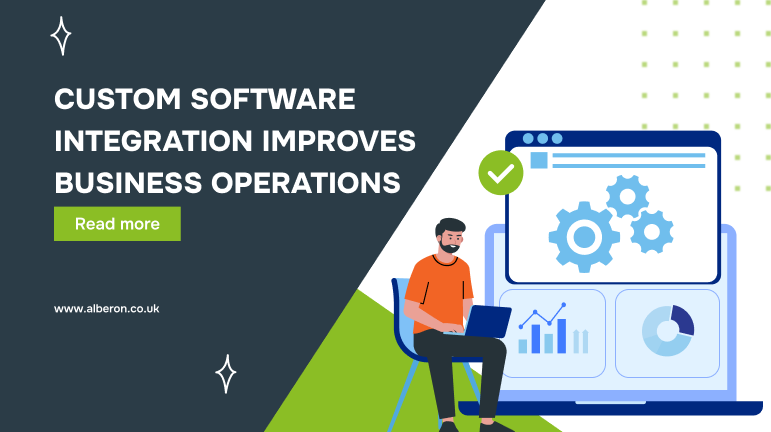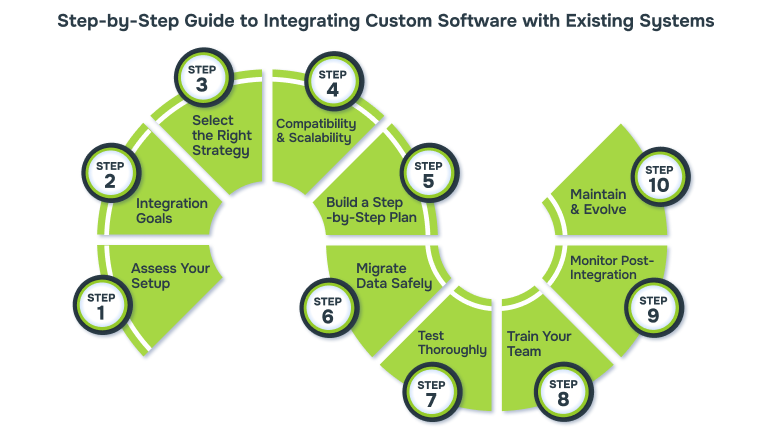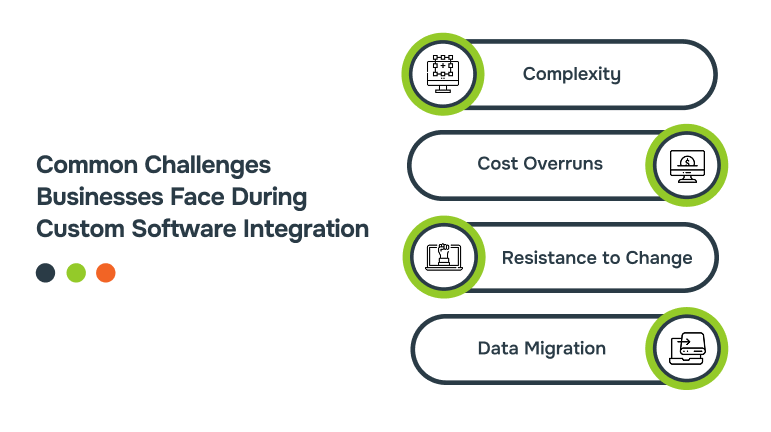How Custom Software Integration Enhances Business Operations
Boost efficiency with custom software integration. Automate tasks, streamline operations, and enhance user experience. Click to transform your business now!

Custom software integration helps businesses streamline operations, eliminate inefficiencies, and scale with ease by connecting previously isolated tools and systems. Whether you’re working with legacy software or looking to improve scalability, integration delivers measurable benefits through automation, improved data flow, and better user experience.
Key Takeaways:
- Eliminates inefficiencies by connecting siloed systems like ERP, CRM, and cloud tools for seamless data flow.
- Boosts scalability and automation, replacing manual processes with integrated, intelligent workflows.
- Delivers a tailored solution that evolves with your business, unlike rigid, off-the-shelf software.
- Improves customer experience through real-time data access and unified communication across departments.
Is your business using multiple tools that don’t quite work together? You’re not alone. Many organisations struggle with disconnected systems, leading to inefficiencies, data silos, and missed opportunities. To stay competitive and agile, businesses need a more innovative, more connected approach.
Custom software integration offers a powerful solution, but it’s not without its challenges. From system compatibility issues to challenges with user adoption, there are key hurdles that businesses need to overcome for a smooth and successful implementation.
In fact, 85% of businesses report significant operational improvements after implementing custom software solutions. Custom software integration is one of the most effective ways to overcome these challenges. By linking your existing tools and platforms, you remove data silos, boost efficiency, and enable a smoother flow of information across your organisation.
In this article, we explore why custom software integration matters, what challenges to expect, and the best practices to ensure a smooth and successful implementation.
What is Custom Software Integration?
Custom software integration refers to the process of connecting different software systems and applications within an organisation to work as one cohesive unit. Unlike off-the-shelf software, which comes with standard features and functionality, custom integration is built to meet the specific needs of your business. This can involve connecting various applications such as:
- ERP Systems (e.g., Microsoft Dynamics 365): Centralise operations like finance, supply chain, and inventory by integrating ERP systems to automate workflows and provide real-time data access.
- CRM Software (e.g., Dynamics 365 CRM): Connect customer data across marketing, sales, and service to create a unified view of every interaction and improve customer experience.
- Cloud Services (e.g., Microsoft 365 & Azure): Enable secure, scalable access to files, apps, and collaboration tools while reducing infrastructure costs and supporting hybrid teams.
- Legacy Systems: Link older systems with modern platforms using middleware or Microsoft Power Platform, maintaining continuity while adding modern capabilities.
- Communication & Collaboration Tools (e.g., Microsoft Teams, Outlook, SharePoint): Streamline communication, document sharing, and team collaboration across departments in real-time, regardless of location.
- Third-party Applications & APIs: Integrate external platforms such as accounting tools, eCommerce systems, or analytics platforms to expand capabilities without switching systems.
- Reporting & Analytics (e.g., Microsoft Power BI): Turn complex data into clear, actionable insights by integrating analytics tools directly into your business workflows.
For example, integrating ERP with CRM ensures seamless data flow between sales and customer service teams, enabling them to work with the most current information and serve clients more effectively. Similarly, automating the supply chain process with integrated software solutions can help reduce delays and improve delivery times.
When Should You Integrate Custom Software into Existing Systems?
Businesses often ask: When is the right time to integrate custom software? While each organisation is different, certain scenarios clearly signal the need for integration. Here are key situations where custom software integration adds real value:
1. Legacy Systems Are Holding You Back
If your existing systems are outdated, slow, or limiting your growth, custom software integration can modernise them. Instead of replacing everything, integration allows you to enhance current tools with new features and improved performance.
2. Struggling to Scale
As your business expands, your software must keep up. If existing systems can’t handle increased workloads or complexity, integration offers scalable solutions to extend their functionality and future-proof your operations.
3. Disconnected Departments and Tools
When teams use separate, unconnected systems, it often leads to data inconsistencies and communication gaps. Custom software integration connects these tools, enabling real-time data sharing and more cohesive operations.
4. Manual Processes Slow You Down
Repetitive manual tasks consume valuable time and resources. By integrating custom software, you can automate these processes, increase efficiency, and reduce human error across departments.
5. Poor Customer Experience
If customer-facing platforms like your CRM, online store, or help desk aren’t connected to your internal systems, customers may experience delays or inconsistent service. Integration ensures all systems work together, delivering a smoother, faster, and more reliable customer experience.
Types of Custom Software Integrations
Custom software integrations come in various forms, each designed to meet specific system requirements and business objectives. Below are the most common types:
1. Data Integration
This type connects different systems to ensure consistent, accurate data across platforms. It’s ideal for businesses needing to sync information between tools like CRMs, ERPs, and inventory systems to maintain data integrity.
2. API Integration
API (Application Programming Interface) integration enables different software applications to communicate through standardised protocols. It’s commonly used to connect custom applications with existing platforms such as accounting software, marketing tools, or eCommerce systems.
3. Enterprise Application Integration (EAI)
EAI focuses on unifying enterprise-level systems like CRM, ERP, and supply chain management tools. The goal is to streamline operations by allowing these systems to share data and function cohesively.
4. Service-Oriented Architecture (SOA) Integration
SOA integration breaks complex systems into smaller, reusable services or components. This modular approach offers flexibility and scalability, making it easy to add or update specific services without disrupting the entire system.
5. Cloud Integration
As cloud adoption grows, cloud integration connects on-premise software with cloud-based applications or links multiple cloud tools together. This ensures seamless data exchange across all environments, improving collaboration and efficiency.
Custom Software vs. Off-the-Shelf Integrations
When considering integration options, businesses often face a choice between custom software integration and off-the-shelf integrations. Here’s a comparison to help guide your decision.
| Criteria | Custom Software Integration | Off-the-Shelf Integrations |
|---|---|---|
| Personalisation | Highly tailored to specific business needs | Limited customisation options |
| Flexibility | Can evolve and scale as the business grows | May require additional purchases or upgrades for scalability |
| Cost | Higher upfront cost, but can provide long-term savings through efficiency | Generally lower initial cost, but may involve hidden costs for future upgrades or add-ons |
| Integration with Existing Systems | Seamless integration with current systems | May require additional work to integrate, or may lack full compatibility |
| Support | Ongoing support tailored to specific business requirements | Standard support with less emphasis on your unique needs |
| Security | Custom security protocols based on business needs | Security features are fixed, which may not address all potential vulnerabilities |
Step-by-Step Guide to Integrating Custom Software with Existing Systems

Integrating custom software with existing systems is often challenging but vital for organisational success. To achieve a smooth integration that enhances efficiency and minimises disruption, it’s important to follow proven best practices. Here are some key guidelines for effective custom software integration:
1. Assess Your Current Setup
Start with a system audit to identify inefficiencies and outdated tools. A clear view of your current tech stack helps avoid disruptions during integration.
- Map out all platforms, tools, and workflows.
- Flag outdated or incompatible components.
2. Set Clear Integration Goals
Define what success looks like. Whether it’s improved workflows, better data access, or cost savings, clear objectives guide the process.
- Align integration with business goals.
- Identify areas where functionality needs improvement.
- Set measurable KPIs (e.g., processing time, error rates).
3. Select the Right Strategy
Choose an integration method that suits your system’s complexity.
- Point-to-Point for simpler setups.
- Middleware for hub-based multi-app connectivity.
- API-based for scalable and flexible integration.
4. Ensure Compatibility & Scalability
The new system should work seamlessly with your current platforms and support future growth.
- Confirm system and hardware compatibility.
- Test for interoperability with other tools.
- Design with scalability in mind.
5. Build a Step-by-Step Plan
A detailed plan helps manage timelines, responsibilities, and risks.
- Define timelines and milestones.
- Assign roles across teams.
- Prepare fallback plans.
6. Migrate Data Safely
Secure data migration protects integrity and ensures a smooth transition.
- Backup existing data.
- Clean out duplicates and errors.
- Use automated tools for safe transfer.
7. Test Thoroughly
Testing is critical before go-live.
- Conduct unit, system, and user acceptance tests.
- Fix any issues early.
8. Train Your Team
Effective training boosts user adoption and reduces friction.
- Customise training for different user roles.
- Provide guides, FAQs, and ongoing support.
9. Monitor Post-Integration
Track performance and adjust as needed.
- Monitor KPIs and usage patterns.
- Gather user feedback for improvements.
- Resolve bottlenecks quickly.
10. Maintain & Evolve
Keep your system current with regular updates and audits.
- Apply updates and patches.
- Reassess compatibility over time.
- Run periodic performance audits.
Common Challenges Businesses Face During Custom Software Integration

Integrating custom software into existing systems can bring immense value, but it’s not without obstacles. From technical issues to user adoption, understanding these challenges early can help ensure a smoother implementation.
- Complexity: Depending on the number of systems being integrated, the process can be complex and time-consuming. It’s essential to have a clear roadmap and skilled professionals handling the integration.
- Cost Overruns: The initial cost of custom integration can be high, but the return on investment (ROI) is often realised over time. Businesses need to plan for both the short-term costs and long-term savings.
- Resistance to Change: Employees accustomed to legacy systems may resist new software. Proper training and change management practices can help mitigate this.
- Data Migration: Moving data from legacy systems to new platforms can be challenging, especially when dealing with large volumes of information.
Custom Software Integration Use Cases
Custom software integration enables businesses to connect previously isolated systems, automate workflows, and gain real-time insights. Below are practical examples across industries where integration drives measurable impact.
| Sector | Workflow Gaps | Custom Software Benefits |
|---|---|---|
| eCommerce | Disconnected systems, manual updates | Real-time inventory, personalised shopping, secure checkout |
| Healthcare | Scattered records, manual scheduling | Centralised data, automated appointments, better care |
| Finance | Siloed data, compliance issues | Integrated platforms, real-time insights, secure access |
| Education | Fragmented tools, poor communication | Unified LMS, remote learning, streamlined admin |
| Retail | Isolated POS/CRM, manual stock | Integrated systems, live updates, customer insights |
| Supply Chain | Inefficient routing, stock issues | Automated scheduling, real-time tracking, and inventory sync |
| Telecom | Data overload, disconnected services | Big data analytics, tailored engagement, network insights |
How Alberon Helps You in Integrating Custom Software?
At Alberon, we specialise in building and integrating custom software that aligns with your business goals and works seamlessly with your existing systems. From connecting CRMs with ERPs to modernising legacy applications and streamlining operations through cloud-based tools, we offer:
- Custom Development & Integration: From APIs to middleware and full-stack solutions, we deliver tailored integrations designed for your unique needs.
- Microsoft Ecosystem Expertise: We work with platforms like Dynamics 365, SharePoint, Power Platform, Microsoft Teams, and Azure to create scalable and powerful integrations.
- Seamless Migration & Testing: We manage data migration, compatibility checks, and rigorous testing to ensure a smooth rollout.
- Training & Support: We provide customised training and ongoing support to help your team make the most of the new system.
Whether you’re modernising your tech stack or integrating new tools into existing systems, our team ensures the process is efficient, secure, and built for the future.
Conclusion
Custom software integration is a continuous journey, not a one-time task. It demands careful planning, regular updates, and a focus on continuous improvement. However, by streamlining business operations and automating workflows, custom integrations allow companies to stay agile and scale with ease.
Moreover, with the right partner, managing integration becomes far less complex. At Alberon, we specialise in developing and integrating custom software solutions that are built around your unique needs, helping you connect systems, eliminate inefficiencies, and future-proof your business.
Simplify workflows with smart custom software integration. Contact us today!
Frequently Asked Questions (FAQs)
1. What is a custom integration?
A custom integration connects two or more software systems in a way that is specifically tailored to your business needs. Unlike off-the-shelf connectors, custom integrations are built to handle unique data workflows, automate specific processes, or sync information across platforms that don’t natively communicate with each other.
2. What is the difference between custom and SaaS?
Custom software is built specifically for an individual organisation’s needs, offering tailored features and functionality. SaaS (Software as a Service), on the other hand, refers to cloud-based software applications that are provided as a subscription service and shared across many users. SaaS is generally faster to deploy but may lack the flexibility of custom-built solutions.
3. Who needs custom software?
Organisations with unique workflows, complex requirements, or industry-specific challenges often need custom software. This includes businesses seeking greater automation, competitive advantages, better scalability, or solutions that existing SaaS products can’t fully address.
4. What are the advantages of custom software?
- Tailored to your needs: Built around your specific business processes.
- Scalable: Grows with your business without being limited by third-party restrictions.
- Competitive edge: Offers unique functionality not available in standard software.
- Integration-ready: Can be designed to integrate with existing tools and systems.
- Better control: Full ownership of features, updates, and data security.
Get in Touch Today:
Ready to Improve your Business Productivity
Get a trusted partner to navigate your digital transformation. With Alberon, you can ensure a smooth transition, clear communication, and peace of mind.
